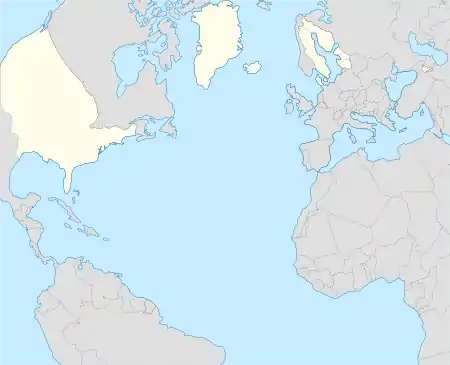| Kauphöll Íslands | |
| Type | Stock exchange |
|---|---|
| Location | Reykjavík, Iceland |
| Founded | 1985 |
| Owner | Nasdaq Nordic |
| Key people | Magnús Harðarson (President) |
| Currency | Icelandic króna |
| No. of listings | 20 (2022) |
| Indices | OMXI8 OMXI10 ICEX Main |
| Website | www |
The Nasdaq Iceland, formerly known as the Iceland Stock Exchange (XICE) (Icelandic: Kauphöll Íslands [ˈkʰœypˌhœtl ˈistlan(t)s]), is a stock exchange located in Iceland. It was established in 1985 as a joint venture of several banks and brokerage firms on the initiative of the central bank.[1][2] Trading began in 1986 in Icelandic government bonds, and trading in equities began in 1991.[2] Equities trading increased rapidly thereafter. A wide variety of firms are currently listed on the exchange, including firms in retail, fishing, transportation, banks, insurance and numerous other areas. Because of the small size of the Icelandic economy and the low cost of public listing, many of the companies traded on the XICE are relatively small and are relatively illiquid.
All domestic trading of Icelandic bonds, equities and mutual funds takes place on the XICE. Bonds and equities are regularly traded, though the liquidity is small in comparison with other exchanges. No mutual funds are currently listed on the market. Since its founding, the XICE has used various electronic systems. Since 2000, it has used the SAXESS system of the NOREX alliance, which allows for the cross-listing of stocks on Nordic stock exchanges. No foreign company lists directly on the XICE, as the small size and illiquidity of the market makes such a move redundant. Conversely, few Icelandic firms have listed abroad, including DeCODE. Faroese bonds were listed on behalf of Virðisbrævamarknaður Føroya in November 2003, and since December 2007 four Faroese equities have been listed on the OMX Nordic Exchange in Iceland.
Since 1 January 1999, the XICE has operated as a private company, owned by the listed companies (29%), member firms (29%), the Central Bank of Iceland (16%), pension funds (13%) and the Association of Small Investors (13%).
Páll Harðarson is the current president of the stock exchange. XICE agreed to be taken over by larger rival OMX Nordic Exchange on 19 September 2006.[3]
On 6 October 2008, the Financial Supervisory Authority decided to temporarily suspend trading on regulated market financial instruments issued by Glitnir, Kaupthing Bank, Landsbanki, Straumur Investment Bank, Spron and Exista.[4] When the exchange reopened on 14 October, the stock index fell by 76%.[5]
After having reached its pre-recession peak of 3495.28 on the 20th of July 2007, the OMX Iceland All-Shares Index collapsed to its bottom at 167.77 on April 8, 2009, a fall of 95.2% from top to bottom. Nine years later, the index was yet to reach 670.[6] As of June 2022, the OMX Iceland All-Shares Index is 2,291.13[7]
List of companies on the XICE
The following is a complete list of companies which are listed on the Iceland Stock Exchange (as of June 25, 2021), and currency in which they trade.[8]
- Arion banki, ISK
- Brim, ISK
- Eik fasteignafélag, ISK
- Eimskipafélag Íslands, ISK
- Festi, ISK
- Hagar, ISK
- Iceland Seafood International, ISK
- Icelandair Group, ISK
- Kvika banki, ISK
- Íslandsbanki, ISK
- Marel, ISK
- Nova, ISK
- Origo, ISK
- Reginn, ISK
- Reitir fasteignafélag, ISK
- Sjóvá-Almennar tryggingar, ISK
- Skeljungur, ISK
- Síldarvinnslan, ISK
- Síminn, ISK
- Sýn, ISK
- Vátryggingafélag Íslands, ISK
- Ölgerðin, ISK
See also
References
- ↑ Bakie, John (30 October 2014). "Nasdaq drops OMX name from branding". The Trade. London. Archived from the original on 20 September 2016. Retrieved 12 June 2015.
- 1 2 "Nordic Large Cap". Nasdaq. Retrieved 11 August 2016.
- ↑ Nasdaq Omx
- ↑ The Financial Supervisory Authority - Iceland, News: Temporary suspension from trading (06.10.2008) Archived 2008-12-11 at the Wayback Machine (in English)
- ↑ The Guardian, Iceland stock index plunges 76 pct as trade resumes (14.10.2008) (in English)
- ↑ Fundamental Finance Playbook, The Icelandic Stock Exchange
- ↑ "OMXIPI, OMX ICELAND ALL-SHARE PI, (IS0000004463)". nasdaqomxnordic.com.
- ↑ Retrieved 25.06.2021

